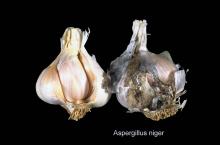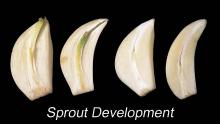Maturity and Quality
Garlic can be harvested at different stages of development for specialty markets, but most garlic is harvested when the bulbs are well mature. Harvest occurs after the tops have fallen and are very dry.
High quality garlic bulbs are clean, white (or other colors typical of the variety), and well cured (dried neck and outer skins). The cloves should be firm to the touch. Cloves from mature bulbs should have a high dry weight and soluble solids content (>35% in both cases).
Grades include U.S. No. 1 and unclassified, and are based primarily on external appearance and freedom from defects. Minimum diameter for fresh market is about 4 cm (1.5 inches).
Postharvest Handling and Storage
-1°C to 0°C (30°F-32°F). The variety of garlic affects potential storage life, and the recommended conditions for commercial storage depend on the expected storage period. Garlic can be kept in good condition for 1-2 months at ambient temperatures (20°C-30°C [68°F-86°F]) under low relative humidity (<75%). However under these conditions, bulbs will eventually become soft, spongy and shriveled due to water loss. For long-term storage, garlic is best maintained at temperatures of -1°C to 0°C (30°F-32°F) with low relative humidity (60-70%). Good airflow is also necessary to prevent any moisture accumilation. Under these conditions garlic can be stored for more than 9 months.
Garlic will eventually lose dormancy, signaled by internal development of the sprout. This occurs most rapidly at intermediate storage temperatures of 5°C-18°C (41°F-65°F). Garlic odor is easily transferred to other products and should be stored separately. High humidity in the storages will favor mold growth and rooting. Mold growth can also be problematic if the garlic has not been well cured before storing.
| Temperature | 0°C (32°F) | 5°C (41°F) | 10°C (50°F) | 15°C (59°F) | 20°C (68°F) |
| ml CO2/kg·hr | |||||
Intact bulbs |
2-6 | 4-12 | 6-18 | 7-15 | 7-13 |
| Fresh peeled cloves | 12 | 15-20 | 35-50 | - | - |
To calculate heat production multiply ml CO2/kg·hr by 440 to get Btu/ton/day or by 122 to get kcal/metric ton/day.
Not sensitive to ethylene exposure.
60 to 70%
Garlic produces only very low amounts of ethylene
Atmospheres with high CO2 (5-15%) are beneficial in retarding sprout development and decay during storage at 0-5°C. Low O2 alone (0.5%) did not retard sprout development of 'California Late' garlic stored up to 6 months at 0°C. Atmospheres with 15% CO2 may result in some yellow translucent discoloration occurring on some cloves after about 6 months.
Disorders
Freeze injury. Due to its high solids content, garlic freezes at temperatures below -1°C (30°F).
Waxy breakdown. A physiological disorder that affects garlic during latter stages of growth and is often associated with periods of high temperature near harvest. Early symptoms are small, light yellow areas in the clove flesh that darken to yellow or amber with time. Finally the clove is translucent, sticky and waxy, but the outer dry skins are not usually affected. Waxy breakdown is commonly found in stored and shipped garlic but rarely in the field. Low oxygen levels and inadequate ventilation during handling and storage may also contribute to development of waxy breakdown.
Penicillium rot. (Pencillium corymbiferum and other spp.) Are common problems in stored garlic. Affected garlic bulbs may show little external evidence until decay is advanced. Affected bulbs are light in weight and the individual cloves are soft and spongy and powdery dry. In an advanced stage of decay, the cloves break down in a green or gray powdery mass. Low humidity in storage retards rot development. Less common storage decay problems include Fusarium basal rot (Fusarium oxysporum cepae) which infects the stem plate and causes shattering of the cloves, dry rot due to Botrytis allii, and bacterial rots (Erwinia spp., Pseudomonas spp.).
Special Considerations
To control sprout development and lengthen the storage period, garlic may be treated with preharvest applications of sprout inhibitors (i.e., maleic hydrazide) or be irradiated after harvest. Outer cloves of bulbs are easily damaged during mechanical harvest and these damaged areas discolor and decay during storage. Therefore high quality garlic for the fresh market is usually harvested manually to avoid mechanical damage.
Curing garlic is the process by which the outer leaf sheaths and neck tissues of the bulb are dried. Warm temperatures, low relative humidity, and good airflow are conditions needed for efficient curing. Under favorable climatic conditions in California, the garlic is usually cured in the field. Curing is essential to obtain maximize storage life and have minimal decay.
Garlic flavor is due to the formation of organosulfur compounds when the main odorless precursor alliin is converted by the enzyme alliinase to allicin and other flavor compounds. This occurs at low rates unless the garlic cloves are crushed or damaged. Alliin content decreases during storage of garlic bulbs, but the effect of time, storage temperatures and atmospheres has not yet been well documented.





